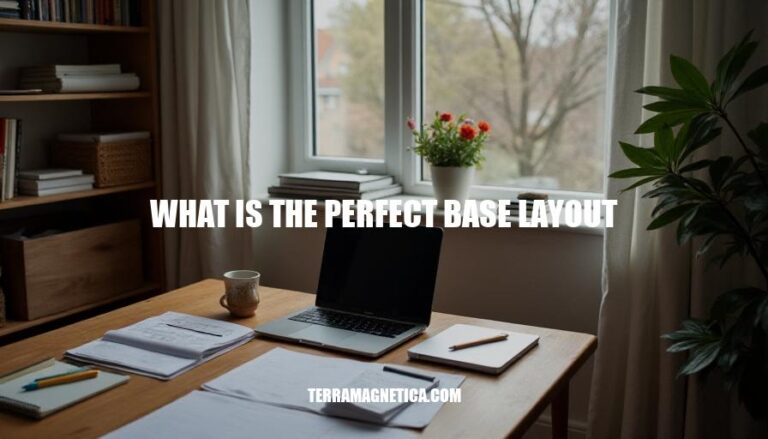


In any strategy game, the foundation of your defense starts with the layout of your base. Whether you’re preparing for attacks from rival clans or safeguarding vital resources, the arrangement of structures is crucial. A well-designed base layout not only maximizes your defensive capabilities but also ensures efficient resource management and overall strategic advantage.
Let’s dive into creating the perfect base layout to bolster your game’s success.
The perfect base layout maximizes efficiency, security, and ease of access. Central command centers should be strategically positioned to ensure quick decision-making and coordination. Resource storage needs to be well-guarded, using natural barriers or strategically placed defenses to deter intruders.
Accommodations should be arranged to optimize space while ensuring comfort and security for inhabitants. The layout must also include robust transportation networks, allowing for swift movement of personnel and materials. Emergency protocols should be integrated seamlessly into the design, with multiple escape routes and clearly marked safety zones.
Finally, it’s important that the base layout is adaptable, capable of evolving with changing needs and threats. This combination ensures a well-rounded, efficient, and secure environment.
Structure Placement: Efficiently placing key structures ensures smooth operations and robust defense.
Town Hall/Headquarters: Central position to make it hard for attackers to reach, sometimes surrounded by powerful defenses.
Resource Storages: Spread out to prevent a single raid from looting everything. Mix storages with defenses for additional protection.
Defensive Structures: Use key defenses like cannons, archer towers, and air defenses to create layers around critical structures. High-damage defenses should protect the center, while splash damage defenses (like mortars) cover larger areas.
Resource Management: Optimal layout also maximizes resource production and safety.
Collectors and Mines: Place these towards the edges for easy collection but interspersed with defenses to make sniping difficult.
Storage Management: Distribute storages to minimize loss during attacks.
Diversify placement to cover air and ground attacks.
Defensive Strategies: Robust defense is paramount for enduring attacks.
Walls: Segmented walls slow down attackers and funnel them into kill zones where defenses can concentrate firepower.
Traps and Bombs: Place strategically to surprise attackers and destroy clustered troops. Use in high-traffic areas and gaps in walls.
Defensive Buildings: Prioritize upgrading high-damage and splash damage defenses. Ensure air and ground defenses are balanced for varied attack strategies.
Clan Castle/Troop Reinforcements: Centralize to ensure defending troops can respond quickly to attacks.
Pro Tip: Continuously adjust the layout based on attack patterns, defense effectiveness, and upgrades to maintain an optimal base.
Adaptation is key to withstanding evolving attack strategies.
To create the perfect base layout, follow these steps carefully:
Identify the Purpose and Requirements:
Determine what the base is for—whether it’s for defense, farming, or hybrid purposes. List out the specific requirements and goals.
Choose the Right Location:
Select an area that offers natural advantages. Look for elevated ground or chokepoints that can be fortified.
Plan Your Layout:
Draft a layout on paper or use digital tools. Divide your base into different zones like living quarters, defensive structures, resource storage, and production areas.
Construct Defensive Structures:
Place walls, towers, and gates strategically. Ensure all entry points are well-guarded. Use natural barriers like rivers and mountains to your advantage.
Optimize Resource Storage:
Place resource storage buildings in the center of your base to protect them from attacks. Surround them with defensive structures.
Build Efficient Pathways:
Create paths that allow quick movement between different sections. Avoid long, straight paths that can be targeted easily.
Arrange Living Quarters:
Place living quarters near the center for protection. Ensure they are easily accessible to resources and defensive points.
Setup Production Areas:
Place production buildings like farms, mines, and factories on the outskirts but within the defensive perimeter.
Integrate Traps and Obstacles:
Use traps, moats, and obstacles to slow down attackers. Place them in strategic locations to maximize their effectiveness.
Ensure Proper Lighting:
Install lighting to prevent surprise attacks at night. Illuminate key areas like entrances and resource storage.
Test and Adjust:
Once the base is constructed, test it against various scenarios. Make adjustments based on weaknesses observed during the tests.
Maintain and Upgrade:
Regularly maintain structures and upgrade them as needed. Ensure the base evolves to meet new threats and requirements.
Following these steps will help you create an efficient and secure base layout tailored to your specific needs.
Firstly, many get too ambitious and try to over-design. They fill every inch with features, forgetting that functionality and simplicity can often go hand in hand. Keeping it streamlined prevents confusion and clutter.
Secondly, people often neglect the importance of adaptability.
They create something too rigid, which struggles to handle unexpected scenarios. Always leave room for future modifications.
Another common mistake: ignoring the importance of balance. They either focus too much on aesthetics, compromising usability, or vice versa.
Striking a balance between looks and functionality is key.
Lastly, there’s a tendency to neglect user feedback. The layout might look perfect on paper, but real-world users can offer insights that can drastically improve it.
Tips to avoid these pitfalls: start simple, stay flexible, focus on balance, and always listen to user feedback. You’ll create something both beautiful and practical.
The perfect base layout is crucial for any strategy game, as it maximizes efficiency, security, and ease of access. A well-designed base should have central command centers, robust transportation networks, emergency protocols, and adaptability to evolving needs and threats.
Structure placement, resource management, and defensive strategies are key considerations when designing a perfect base layout. Efficiently place key structures, such as town halls, resource storages, and defensive structures, to ensure smooth operations and robust defense.
Robust defense is paramount for enduring attacks. Prioritize upgrading high-damage and splash damage defenses, use walls to slow down attackers, and place traps and bombs strategically to surprise attackers and destroy clustered troops.
Continuously adjust the layout based on attack patterns, defense effectiveness, and upgrades to maintain an optimal base.
Start simple, stay flexible, focus on balance, and listen to user feedback to create a perfect base layout that is both beautiful and practical.